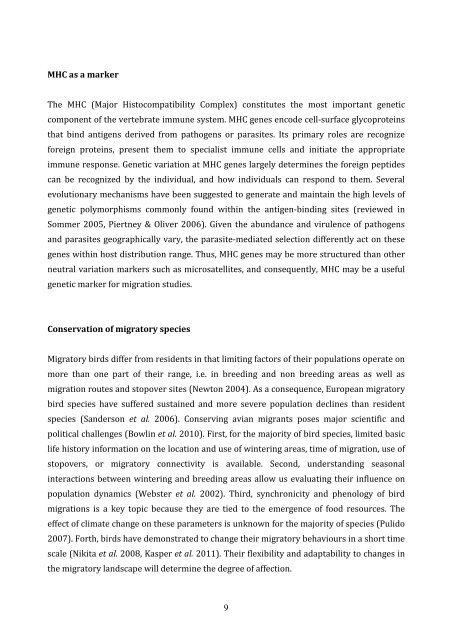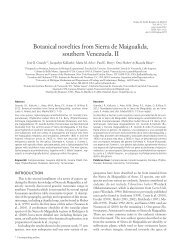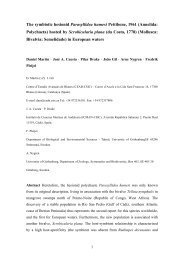examples from the threatened lesser kestrel - Digital.CSIC, the ...
examples from the threatened lesser kestrel - Digital.CSIC, the ...
examples from the threatened lesser kestrel - Digital.CSIC, the ...
You also want an ePaper? Increase the reach of your titles
YUMPU automatically turns print PDFs into web optimized ePapers that Google loves.
MHC as a marker<br />
The MHC (Major Histocompatibility Complex) constitutes <strong>the</strong> most important genetic<br />
component of <strong>the</strong> vertebrate immune system. MHC genes encode cell-surface glycoproteins<br />
that bind antigens derived <strong>from</strong> pathogens or parasites. Its primary roles are recognize<br />
foreign proteins, present <strong>the</strong>m to specialist immune cells and initiate <strong>the</strong> appropriate<br />
immune response. Genetic variation at MHC genes largely determines <strong>the</strong> foreign peptides<br />
can be recognized by <strong>the</strong> individual, and how individuals can respond to <strong>the</strong>m. Several<br />
evolutionary mechanisms have been suggested to generate and maintain <strong>the</strong> high levels of<br />
genetic polymorphisms commonly found within <strong>the</strong> antigen-binding sites (reviewed in<br />
Sommer 2005, Piertney & Oliver 2006). Given <strong>the</strong> abundance and virulence of pathogens<br />
and parasites geographically vary, <strong>the</strong> parasite-mediated selection differently act on <strong>the</strong>se<br />
genes within host distribution range. Thus, MHC genes may be more structured than o<strong>the</strong>r<br />
neutral variation markers such as microsatellites, and consequently, MHC may be a useful<br />
genetic marker for migration studies.<br />
Conservation of migratory species<br />
Migratory birds differ <strong>from</strong> residents in that limiting factors of <strong>the</strong>ir populations operate on<br />
more than one part of <strong>the</strong>ir range, i.e. in breeding and non breeding areas as well as<br />
migration routes and stopover sites (Newton 2004). As a consequence, European migratory<br />
bird species have suffered sustained and more severe population declines than resident<br />
species (Sanderson et al. 2006). Conserving avian migrants poses major scientific and<br />
political challenges (Bowlin et al. 2010). First, for <strong>the</strong> majority of bird species, limited basic<br />
life history information on <strong>the</strong> location and use of wintering areas, time of migration, use of<br />
stopovers, or migratory connectivity is available. Second, understanding seasonal<br />
interactions between wintering and breeding areas allow us evaluating <strong>the</strong>ir influence on<br />
population dynamics (Webster et al. 2002). Third, synchronicity and phenology of bird<br />
migrations is a key topic because <strong>the</strong>y are tied to <strong>the</strong> emergence of food resources. The<br />
effect of climate change on <strong>the</strong>se parameters is unknown for <strong>the</strong> majority of species (Pulido<br />
2007). Forth, birds have demonstrated to change <strong>the</strong>ir migratory behaviours in a short time<br />
scale (Nikita et al. 2008, Kasper et al. 2011). Their flexibility and adaptability to changes in<br />
<strong>the</strong> migratory landscape will determine <strong>the</strong> degree of affection.<br />
9

















